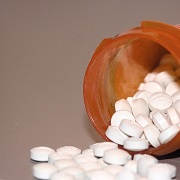Could More Competition Reduce Rising Prescription Drug Costs?
Competition is one necessary solution for reducing the rising rates of prescription drug costs.
- Prescription drug costs seem to be higher than ever before. Merrill Matthews, Resident Scholar at the Institute for Policy Innovation, wrote about some of the reasons behind these high prices and the solutions that could lower prescription drug costs.

First and foremost, the research and development spending related to prescription drug costs can be very extensive with many drug manufacturers stating that they spent up to $51.2 billion on research and development in 2014.
The other important point to remember is that drug approvals by the Food and Drug Administration (FDA) don’t happen as quickly as hoped, as it averages out to about 20 to 30 drug approvals each year, states Matthews.
The results show that more than $1 billion is spent manufacturing each drug after the FDA approves its path to market. Another potential issue is that many drugs have the potential to fail when moving through clinical trials.
In recent years, there has been an uptick of orphan drug development or more complex medications – often in the form of injectable biologics – that target smaller populations of the patient community.
While in the first half of the 1990s, the FDA approved no more than 89 orphan drugs, these numbers have skyrocketed in recent years. For example, in 2013, the FDA approved 260 new molecules to have an orphan drug status and in 2014, 293 medications achieved this same status.
Since smaller populations of patients can actually benefit from these orphan drugs, the prescription drug costs must rise exponentially to counter the effect of the miniscule patient groups.
“While R&D [research and development] spending is rising at a relatively steady pace, the number of potential patients who can benefit from the new drugs is shrinking dramatically. That means the cost of those new drugs to the relative handful of patients who need them rises exponentially. In short, the math is working against us,” Matthews wrote.
Health insurance companies have attempted to overcome some of these rising prices in medication. Premium costs have risen to account for increasing healthcare costs while other health payers have looked toward stabilizing premium prices by requiring consumers to cover more out-of-pocket costs, Matthews explains.
Tiered pricing is becoming a new norm in the health insurance industry as many payers seek out new ways to reduce prescription drug costs. Tiered pricing involves separating generic drugs from brand name drugs and even including preferred or less expensive medications.
High-cost specialty drugs are even getting a fourth tier among many health payers today. Matthews writes that competition is one necessary solution for reducing the rising rates of prescription drug costs.
Drug manufacturing companies that release competing medications often set the price at a lower rate when releasing the product to market. Greater competition may be what the pharmaceutical industry needs in order to ensure the costs of medications are affordable for consumers and, thereby, providers. When drugs are too pricey and patients forego the medication, emergency room or hospital admission costs will lead to wasteful spending that could have been prevented.
The Centers for Medicare & Medicaid Services (CMS) has also established its own solution for reducing the pricing of prescription drugs. The federal agency has announced new reimbursement changes for the Medicare Part B program.
The proposal seeks to assist clinicians in assigning the best and most effective medications for their patients. The ruling looks to incentivize doctors as well as patients in choosing high quality prescription drugs.
Positive patient health outcomes will be tied directly to reward and reimbursement associated with prescribing the most effective drugs. In particular, CMS is looking to put an end to incentives in the fee-for-service reimbursement system that keeps doctors from assigning well-performing medication.
The Healthcare Supply Chain Association has supplied Congress with key information about the rising prices of generic drugs and ways to eliminate the jump in costs. For example, the Food and Drug Administration (FDA) could help reduce these costs if the drug approval process was streamlined and expedited especially among medications in which only one or two companies are manufacturing the product and price jumps have been clear.

“We are concerned that generic price spikes, often caused by monopoly or duopoly situations, are negatively impacting competition, cost, and available supply of necessary drugs.”
Greater competition throughout the healthcare industry as well as a reduction in generic drug price hikes may benefit both providers as well as the patient community. The solutions set forth could help better control rising healthcare spending and decrease the elevated prescription drug costs affecting providers, payers and consumers around the country.
